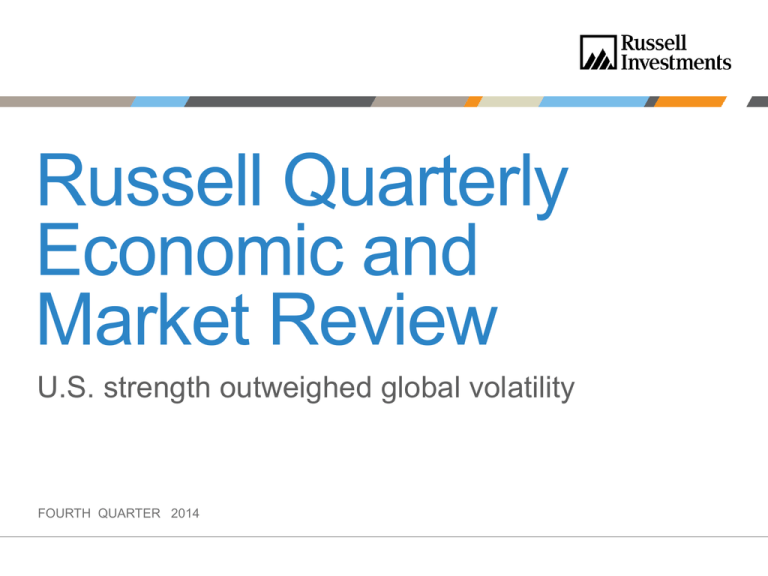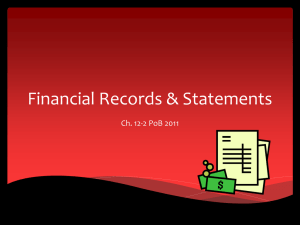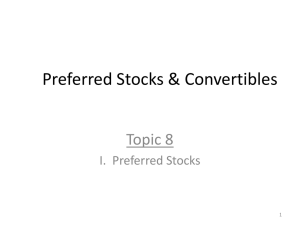
Russell Quarterly
Economic and
Market Review
U.S. strength outweighed global volatility
FOURTH QUARTER 2014
Important information and disclosures
Please remember that all investments carry some level of risk, including the potential loss of Principal
invested. They do not typically grow at an even rate of return and may experience negative growth. As
with any type of portfolio structuring, attempting to reduce risk and increase return could, at certain
times, unintentionally reduce returns.
Diversification does not assure a profit and does not protect against loss in declining markets.
Nothing contained in this material is intended to constitute legal, tax, securities, or investment advice, nor an opinion regarding the appropriateness of any
investment, nor a solicitation of any type. The general information contained in this publication should not be acted upon without obtaining specific legal, tax, and
investment advice from a licensed professional.
Source for MSCI data: MSCI. MSCI makes no express or implied warranties or representations and shall have no liability whatsoever with respect to any MSCI
data contained herein. The MSCI data may not be further redistributed or used as a basis for other indices or any securities or financial products. This report is
not approved, reviewed or produced by MSCI.
Standard & Poor’s Corporation is the owner of the trademarks, service marks, and copyrights related to its indexes. Indexes are unmanaged and cannot be
invested in directly.
Standard Deviation is a statistical measure of the degree to which an individual value in a probability distribution tends to vary from the mean of the distribution.
The greater the degree of dispersion, the greater the risk.
Russell Investments is a trade name and registered trademark of Frank Russell Company, a Washington USA corporation, which operates through subsidiaries
worldwide and is part of London Stock Exchange Group.
Copyright © Russell Investments 2015. All rights reserved. This material is proprietary and may not be reproduced, transferred, or distributed in any form without
prior written permission from Russell Investments. It is delivered on an “as is” basis without warranty.
Russell Financial Services, Inc., member FINRA, part of Russell Investments.
Date of First Use: January 2015
RFS 15-14090
Not FDIC Insured
May Lose Value
No Bank Guarantee
p.2
Table of contents
Topic
Page
Top news and events in 2014
4
Economic indicators dashboard
6
Capital markets
7
Commodities – Falling oil prices driven by supply and demand
9
Currency – Factors affecting currency
11
Non-U.S. equity – A reason to diversify: market leadership rotates
13
Global asset classes and balanced index portfolio returns
15
Russell’s 2015 economic and market outlook
16
Conclusion – 2015: Extraordinary ride to an ordinary outcome?
17
p.3
Top news and events in 2014
ALARMIST HEADLINES FAILED TO DISRUPT MARKET’S CLIMB
€
MARCH
Malaysia Airlines 370 disappearance
Weak
Euro
JUNE–DECEMBER
Oil falls from $115 to $50/barrel
$
Strong
Dollar
MARCH
Russia annexes Crimea
SEPTEMBER
Scottish vote for independence
$11,500
3.0
$11,000
2.0
$10,500
1.0
$10,000
0.0
$9,500
-1.0
$9,000
-2.0
$8,500
-3.0
U.S. Equities daily return
U.S. Equities growth (monthly)
U.S. Equities daily return (%)
JULY
Malaysia Airlines 17 Ukraine crash
Growth of $
Volatility and Growth
JUNE
ISIS declares caliphate
AUGUST
Ferguson riots
School shootings / gun violence
in USA
SEPTEMBER
Ebola lands in America
OCTOBER
Virgin Galactic crash
FEBRUARY
Yellen sworn in as U.S. Fed chief
U.S. Equities represented by Russell 3000® Index.
Index returns represent past performance, are not a guarantee of future performance, and are not indicative of any specific investment. Indexes are unmanaged and cannot be invested in directly.
p.4
Historically it has paid to own stocks
73% OF THE TIME, U.S. EQUITY MARKET1 HAS POSTED CALENDAR RETURNS ABOVE ZERO
Calendar Year S&P 500® Index Returns:
1926-2014
1931
2008
1937
-50% -40%
2002
1974
1930
-30%
2001
1973
1966
1957
1941
2000
1990
1981
1977
1969
1962
1953
1946
1940
1939
1934
1932
1929
-20% -10%
2014
2012
2010
2006
2004
1993
1988
1986
1979
1972
1971
1968
1965
1964
1959
1952
1949
1944
1926
2011
2007
2005
1994
1992
1987
1984
1978
1970
1960
1956
1948
1947
0%
10%
2009
2003
1999
1998
1996
1983
1982
1976
1967
1963
1961
1951
1943
1942
20%
2013
1997
1995
1991
1989
1985
1980
1975
1955
1950
1945
1938
1936
1927
30%
1958
1935
1928
40%
1954
1933
50%
60%
Rates of return
When the U.S. stock market exceeded 10%,
the following year’s average return was 12%
1Represented
by the S&P 500® Index from 1926-2014
Index returns represent past performance, are not a guarantee of future performance, and are not indicative of any specific investment. Indexes are unmanaged and cannot be invested in directly.
p.5
Economic Indicators Dashboard
VOLATILITY
› Volatility increased in
4Q 2014 but was still
low for most of the year
INTEREST RATES
› The 10-year U.S.
Treasury yield surprised
many by ending the
year 85 basis points
lower than it started
UNEMPLOYMENT
› Slow but steady decline
over the course of the
year
http://www.russell.com, Current state as of 1/1/2015. See appendix for category definitions.
Russell’s Economic Indicators Dashboard charts several key indicators to help investors assess economic and market trends.
p.6
Capital markets
PERIODS ENDING DECEMBER 31, 2014
Capital market returns
25
U.S. Equity
20.5
Non-U.S. Developed Equity
20
Emerging Markets
12.6
Rate of return (%)
7.9
Commodities
6.0
5.2
5
11.3
10.9
Global REITs
10
15.6
15.1
15.0
U.S. Bonds
15
5.6
5.3
2.7
2.7
1.8
8.8
7.9
4.9
4.4
4.7
6.0
0
-5
-3.5
-4.0
-4.8
-1.7
-1.9
-5.5
-10
-9.4
-12.1
-15
-17.0
-20
4Q 2014
1-Year
3-Years
Annualized
U.S. Equity: (Russell 3000® Index) U.S. stock index which includes the
3,000 largest U.S. stocks as measured by market capitalization
Non-U.S. Developed Equity: (Russell Developed ex-U.S. Large Cap
Index) International market index that includes Western Europe, Japan,
Australia and Canada
Emerging Markets: (Russell Emerging Markets Index) Emerging
markets index that includes S. Korea, Brazil, Russia, India and China
U.S. Bonds: (Barclays U.S. Aggregate Bond Index) Broad index for
U.S. Fixed Income market
Global REITs: (FTSE EPRA/NAREIT Index) Index for global publicly
traded real estate securities
Commodities: (Bloomberg Commodity Index Total Return*) Broad
index of common commodities
5-Years
Capital Markets:
› The U.S. equity market continued its strong run reflecting its
leadership role in the global economic recovery
› Non-U.S. developed equity markets posted negative results for U.S.
investors influenced by growth concerns and a strong dollar
› Slumping commodity prices and U.S. dollar strength created a
headwind for emerging market stocks in 2014
› Surprising year for bonds as interest rates lowered and bond prices
rose accordingly
› Global REITs benefited from lower interest rates and posted one of
the best asset class returns in 2014
› Dropping energy prices hit commodity indexes hard as reflected by
double-digit drops for the quarter and year
Source: Russell, Barclays, Bloomberg, and FTSE NAREIT.
*Effective July 1, 2014, the Dow Jones-UBS Commodity Index Total Return was renamed the Bloomberg Commodity Index Total Return.
Index returns represent past performance, are not a guarantee of future performance, and are not indicative of any specific investment.
p.7
10-Years
What worked and what didn’t in 2014
INTEREST RATES AND STRONG DOLLAR IMPACTED RESULTS
Partners
What didn’t work
Advisors
What
worked
Return (%)
2014 Calendar year returns
20.0
15.0
10.0
5.0
0.0
-5.0
-10.0
-15.0
-20.0
15.0
13.2
12.1
6.2
6.0
5.2
4.9
4.7
0.0
-0.1
Global REITs U.S. Large Infrastructure
Cap
EMD
U.S. Bonds Global Equity U.S. Small
Cap
Equities
Interest
rates helped
› REITs were strongest asset segment
› EMD benefited from higher yielding
bonds and USD issuance
› U.S. bonds exceeded expectations
Balanced
Index
Portfolio
Alternatives
Non-dollar
exposure
hurt
Cash
Global HY
-1.7
EM Equity
-4.0
-17.0
Non-U.S. Commodities
Equity
Fixed Income
› Equities outside the U.S. finished up
in local currency, down in USD
› Emerging markets and commodities
impacted by growth concerns
U.S. Small Cap: Russell 2000® Index; U.S. Large Cap: Russell 1000® Index; Global: Russell Developed Large Cap Index; Non-U.S.: Russell Developed ex-U.S. Large Cap Index; Infrastructure: S&P
Global Infrastructure Index; Global High Yield: Barclays Global High Yield Index; Global REITs: FTSE EPRA/NAREIT Developed Index; Cash: Citigroup 1-3 Month Treasury Bill Index; EM Equity:
Russell Emerging Markets Index; U.S. Bonds: Barclays U.S. Aggregate Index; EMD: JPMorgan EM Bond Index Plus; Commodities: Bloomberg Commodity Index; Balanced Index: 5% U.S. Small
Cap,15% U.S. Large Cap,10% Global, 12% Non-U.S., 4% Infrastructure, 5% Global High Yield, 4% Global REITs, 0% Cash, 6% EM Equity, 30% U.S. Bonds, 5% EMD and 4% Commodities.
Index returns represent past performance, are not a guarantee of future performance, and are not indicative of any specific investment. Indexes are unmanaged and cannot be invested in directly.
p.8
Global oil production
Net oil imports as % of GDP
(1992–2013)
(2013)
95,000
14%
90,000
85,000
12%
80,000
10%
75,000
8%
70,000
6%
65,000
4%
60,000
2%
55,000
0%
50,000
-20.0%
Global supply (1,000 barrels/day)
16%
1992
1993
1994
1995
1996
1997
1998
1999
2000
2001
2002
2003
2004
2005
2006
2007
2008
2009
2010
2011
2012
2013
Production by country (% of total)
Falling oil prices driven by supply and demand
United States
Russia
Canada
Russia
-15.0%
U.K.
France
1.1%
1.7%
2.3%
Japan
›
›
›
›
p.9
-4.2%
China
Demand
Source: U.S. Energy Information Administration, International Monetary Fund, Russell Investments.
5.0%
2.3%
Germany
›
0.0%
U.S.
Supply
Total global supply increasing
U.S. leading global oil producer
OPEC not reducing output to support
price
-5.0%
-14.4%
Canada
Saudi Arabia
China
United Arab Emirates
-10.0%
2.8%
4.7%
Net exporting countries negatively
impacted by falling price
Net importers stand to gain from lower oil
costs representing reduced input costs
Potential implications of cheap oil in 2015
Challenges:
Price of oil
› Curtails global
growth
› Inflation
concerns
Too high
~ $110/barrel
› High-yield bonds of energy companies: Energy has
become the largest sector of the high yield bond
market*. Extended low oil prices may put pressure on
select energy firms’ ability to service their debt.
› Energy companies in general: Firms that are undercapitalized may face financial stresses, including
reduced hiring and reduced capital expenditures.
› Deflation
› Acceptable
price range
Opportunities:
› Consumer: Extra money in consumer pockets
(unofficial tax cut) may benefit other sectors –
retail / consumer goods
› Foreshadows
growth
concerns
› Deflation
› Flight to safety
›
Too low
~ $40/barrel
U.S. drivers saved $14 billion in 2014 / $50- $75 billion
projected in 2015 in gasoline expenditures**
› Companies: Those with high oil inputs may be more
attractive
›
Airlines, auto, trucking, fertilizers (Air Transport stocks up
54% in 2014)***
Sources: *High Yield Energy: Barclays HY Index; **Gas price data per AAA; ***Russell Investments: Russell 3000® Air Transport Subsector. As of December 2014.
There is no guarantee the stated projections will occur.
p.10
Factors affecting currency
ECONOMIC STRENGTH, CENTRAL BANK ACTION AND INTEREST RATES
Central bank policies around the
globe are moving in different
directions
United States Dollar Index*
1995–2014
125
120
› U.S. and U.K. likely to raise interest
rates in 2015
› Eurozone and Japan poised to keep
interest rates low
› Both currencies weakened in 2014
› A weaker currency could help exporters
boost trade and encourage foreign
tourism
105
Dollar
surges
in 2014
100
95
90
85
80
75
70
1995
1996
1997
1998
1999
2000
2001
2002
2003
2004
2005
2006
2007
2008
2009
2010
2011
2012
2013
2014
› A strong U.S. dollar tends to help
importers, but may hurt exporters, trade
and foreign tourism
110
Index level
› The U.S. dollar surged against other
major currencies in 2014, reflecting a
strengthening U.S. economy
115
*Measures performance of the U.S. Dollar against a
basket of currencies.
Source: Factset, New York Board of Trade. The U.S. Dollar Index measures the performance of the U.S. Dollar against a basket of currencies: 57.6% EUR, 13.6% JPY, 11.9% GBP, 9.1% CAD,
3.6% CHF and 4.2% SEK.
Index returns represent past performance, are not a guarantee of future performance, and are not indicative of any specific investment. Indexes are unmanaged and cannot be invested in directly.
p.11
Don’t react to short-term currency volatility
1-YEAR
SHORT-TERM RETURNS
› The strong U.S. dollar
hurt non-U.S. returns
for U.S. investors
› Europe, Japan, and
the U.K. fared well in
local currency terms
as their economies
improved
Short-term country and regional returns
Annualized returns as of 12/31/2014 (Local and USD)
15%
12.7% 12.7%
9.8%
10%
1-yr return % (USD)
6.3%
4.9%
5%
1-yr return % (Local)
4.7%
9.5%
7.9%
6.6%
5.7%
0.5%
0%
-0.5%
-5%
-4.3%
-10%
U.S.
World
World exU.S.
-2.7%
-6.2%
Europe
-4.0%
-5.4%
-6.6%
Europe ex- United
U.K.
Kingdom
Pacific
Pacific exJapan
Japan
Long-term country and regional returns
Annualized returns as of 12/31/14 (Local and USD)
10-YEAR
LONG-TERM RETURNS
15%
› Over longer time
periods, the effect of
currency has been
muted
10%
10-yr return % (USD)
7.2% 7.2%
10-yr return % (Local)
8.4%
6.0% 6.3%
5%
5.5%
4.6%
5.8%
4.6%
6.8%
5.4%
4.6%
4.6%
7.7%
4.8%
4.2%
3.9%
2.3%
0%
U.S.
World
World exU.S.
Europe
Europe ex- United
U.K.
Kingdom
Pacific
Pacific exJapan
Japan
Source: MSCI. MSCI USA Index; MSCI World Index; MSCI World ex USA Index; MSCI Europe Index; MSCI Europe ex UK Index; MSCI United Kingdom Index; MSCI Pacific Index; MSCI Pacific
ex Japan Index; MSCI Japan Index.
Index returns represent past performance, are not a guarantee of future performance, and are not indicative of any specific investment. Indexes are unmanaged and cannot be invested in directly.
p.12
A reason to diversify: market leadership rotates
U.S. equity excess return vs. other asset classes
2001–2007
20.0
2008–2014
20.0
15.1
15.0
U.S. stocks underperformed
non-U.S. stocks by 5.1% per year
10.0
5.0
0.0
-2.1
-5.0
-5.1
-6.5
-10.0
-15.0
-18.7
Non-U.S.
Equity
EM Equity
10.0
7.6
8.4
4.7
5.0
2.7
0.0
-5.0
-10.0
U.S. stocks outperformed
non-U.S. stocks by 7.6% per year
-15.0
-14.0
-20.0
Annualized excess returns
Annualized excess returns
15.0
-20.0
U.S. Bonds
REITs
Commodities
Non-U.S.
Equity
EM Equity
U.S. Bonds
REITs
Commodities
› U.S. equity strongly outperformed all major asset classes from 2008–2014
› But the previous seven years exhibited the opposite trend
Source: U.S. Equity: Russell 1000® Index; Non-U.S. Equity: Russell Developed ex-U.S. Large Cap Index; REITs: Linked FTSE NAREIT All Equity REITs Index January 2001 – February 2005/FTSE
EPRA/NAREIT Developed Index March 2005 – December 2014; Emerging Markets Equity: Russell Emerging Markets Index; U.S. Bonds: Barclays U.S. Aggregate Bond Index; Commodities:
Bloomberg Commodity Index.
Index returns represent past performance, are not a guarantee of future performance, and are not indicative of any specific investment. Indexes are unmanaged and cannot be invested in directly.
p.13
Returns (%)
Market reactions to Federal Funds Rate increases
12.0
10.0
8.0
6.0
4.0
2.0
0.0
-2.0
Historical capital market returns after first rate hikes
Average returns for last eight rate hike cycles
11.1
8.9
6.2
2.4
2.0
-0.5
U.S. Bonds
U.S. Stocks
Time of
initial Fed
hike
Rate
at 1st
hike
5 YEARS ANNUALIZED
FIRST YEAR
FIRST 3 MONTHS
FIVE
YEARS
ANNUALIZED
FIRST
YEAR
FIRST 3
MONTHS
Stocks
Bonds
Stocks
Bonds
Stocks
Bonds
May-71
4.2%
-7.3
-1.5
13.3
7.8
3.8
6.6
May-77
4.7%
1.6
2.1
6.6
2.4
9.7
4.6
Aug-80
9.0%
7.7
-5.7
6.0
-3.6
14.0
14.7
May-83
8.6%
2.0
-3.5
-7.1
0.4
12.6
12.0
Nov-86
6.0%
11.5
3.2
-7.6
1.8
11.5
9.4
Apr-88
6.6%
6.6
1.2
22.0
7.9
14.6
11.3
Jan-94
3.0%
-3.8
-2.9
-0.7
-2.3
22.3
7.1
Jul-04
1.0%
-1.9
3.2
16.9
4.8
0.4
5.1
› Federal Reserve
interest rate hike
anticipated for 2015
› Capital markets history
has demonstrated
mixed results after
prior rate hikes
› First year returns have
been “below average”
› Five-year returns are
within normal historical
ranges
Sources: Federal Reserve Bank of New York, Stocks: S&P 500® Index (1970 – 1978) and Russell 3000® Index (1979 – Present), Bonds: Barclays U.S. Aggregate Bond Index.
Index returns represent past performance, are not a guarantee of future performance, and are not indicative of any specific investment. Indexes are unmanaged and cannot be invested in directly.
p.14
Global asset classes and balanced index portfolio returns
THE LACK OF REPEATABLE PATTERNS IS WHY INVESTORS DIVERSIFY
10 Years
ending
12/04*
2005
2006
2007
2008
2009
2010
2011
2012
2013
2014
10 Years
ending
12/14†
GLOBAL REAL
ESTATE
14.8
EMERGING
MARKETS
32.6
GLOBAL REAL
ESTATE
41.8
EMERGING
MARKETS
40.9
U.S.
TREASURIES
6.6
EMERGING
MARKETS
83.8
EMERGING
MARKETS
21.7
U.S. BONDS
7.8
GLOBAL REAL
ESTATE
27.7
U.S. EQUITY
33.6
GLOBAL REAL
ESTATE
15.0
EMERGING
MARKETS
8.8
U.S. EQUITY
12.0
COMMODITIES
21.4
INFRASTRUCTURE
38.6
INFRASTRUCTURE
22.4
U.S. BONDS
5.2
GLOBAL
BONDS
60.7
GLOBAL REAL
ESTATE
19.6
GLOBAL
BONDS
3.2
GLOBAL
BONDS
18.9
GLOBAL
EQUITY
27.4
U.S. EQUITY
12.6
U.S. EQUITY
7.94
BALANCED
9.4
NON-U.S.
EQUITY
14.3
EMERGING
MARKETS
33.4
COMMODITIES
16.2
GLOBAL
BONDS
(27.0)
GLOBAL REAL
ESTATE
37.1
U.S. EQUITY
16.9
U.S.
TREASURIES
1.5
EMERGING
MARKETS
18.8
NON-U.S.
EQUITY
21.7
INFRASTRUCTURE
12.1
GLOBAL
BONDS
7.9
GLOBAL
EQUITY
9.2
INFRASTRUCTURE
14.2
NON-U.S.
EQUITY
25.9
NON-U.S.
EQUITY
13.2
BALANCED
(27.4)
NON-U.S.
EQUITY
35.6
COMMODITIES
16.8
INFRASTRUCTURE 1.3
NON-U.S.
EQUITY
16.7
INFRASTRUCTURE
14.0
U.S. BONDS
6.0
INFRASTRUCTURE
7.8
GLOBAL
BONDS
8.8
GLOBAL REAL
ESTATE
11.8
GLOBAL
EQUITY
20.1
GLOBAL
EQUITY
9.2
COMMODITIES
(35.6)
GLOBAL
EQUITY
31.5
GLOBAL
BONDS
15.4
U.S. EQUITY
1.0
U.S. EQUITY
16.4
BALANCED
12.5
GLOBAL
EQUITY
5.2
GLOBAL
EQUITY
6.3
COMMODITIES
8.4
GLOBAL
EQUITY
9.6
U.S. EQUITY
15.7
BALANCED
9.1
U.S. EQUITY
(37.3)
U.S. EQUITY
28.3
BALANCED
12.8
BALANCED
(1.3)
GLOBAL
EQUITY
16.2
GLOBAL
BONDS
7.1
BALANCED
4.7
BALANCED
6.1
U.S. BONDS
7.7
BALANCED
8.9
BALANCED
15.0
U.S.
TREASURIES
7.3
INFRASTRUCTURE
(39.5)
BALANCED
24.4
GLOBAL
EQUITY
12.4
GLOBAL
EQUITY
(5.7)
BALANCED
12.1
GLOBAL REAL
ESTATE
3.7
GLOBAL BONDS
2.5
GLOBAL REAL
ESTATE
5.9
NON-U.S.
EQUITY
6.8
U.S. EQUITY
6.1
GLOBAL
BONDS
12.0
U.S. BONDS
7.0
GLOBAL
EQUITY
(41.2)
INFRASTRUCTURE
24.0
NON-U.S.
EQUITY
9.6
GLOBAL REAL
ESTATE
(6.5)
INFRASTRUCTURE
10.9
U.S.
TREASURIES
0.4
U.S.
TREASURIES
0.6
NON-U.S.
EQUITY
4.9
U.S.
TREASURIES
5.7
GLOBAL
BONDS
3.3
U.S. BONDS
4.3
U.S. EQUITY
5.1
NON-U.S.
EQUITY
(44.2)
COMMODITIES
18.9
U.S. BONDS
6.5
NON-U.S.
EQUITY
(12.3)
U.S. BONDS
4.2
EMERGING
MARKETS
0.02
EMERGING
MARKETS
(1.7)
U.S. BONDS
4.7
EMERGING
MARKETS
2.4
U.S. BONDS
2.4
U.S.
TREASURIES
3.9
GLOBAL
BONDS
1.7
GLOBAL REAL
ESTATE
(48.2)
U.S. BONDS
5.9
INFRASTRUCTURE
4.8
COMMODITIES
(13.3)
U.S.
TREASURIES
0.4
U.S. BONDS
(2.0)
NON-U.S.
EQUITY
(4.0)
U.S.
TREASURIES
2.5
INFRASTRUCTURE
N/A
U.S.
TREASURIES
1.7
COMMODITIES
2.1
GLOBAL REAL
ESTATE
(7.4)
EMERGING
MARKETS
(55.5)
U.S.
TREASURIES
0.8
U.S.
TREASURIES
2.4
EMERGING
MARKETS
(19.4)
COMMODITIES
(1.1)
COMMODITIES
(9.5)
COMMODITIES
(17.0)
COMMODITIES
(1.9)
*Annualized return. †10 year period ending 12/03: International – MSCI EAFE Index (1/1/1995 – 6/28/1996) & Russell Developed ex-U.S. Large Cap Index; Global Equity – MSCI World Index (1/1/1995 – 6/28/1996) & Russell Developed Large Cap Index; Emerging
Markets – MSCI Emerging Markets Index (1/1/1995 – 6/28/1996) & Russell Emerging Markets Index; Global Real Estate – FTSE NAREIT Equity REITs (1/1/1995 – 2/18/2005) & FTSE NAREIT Dev. Balanced: 30% Russell 3000® Index; 35% Barclays U.S. Aggregate;
20% Russell Developed ex-U.S. LC; 5% Russell Emerging Markets; 5% FTSE NAREIT all Equity; 5% Bloomberg Commodity. Please note that this chart is based on past index performance and is not indicative of future results. Indexes are unmanaged and cannot be
invested in directly. Index performance does not include fees and expenses an investor would normally incur when investing in a mutual fund. Diversification and strategic asset allocation do not assure profit or protect against loss in declining markets.
p.15
Russell’s 2015 economic & market outlook
Economic
outlook
Market
outlook
UNITED STATES
EUROZONE
ASIA
continued strength
building momentum
more of the same
› Forecast 3.0% real GDP
growth and 2.0% core inflation
› Employment gains projected at
+200k/mo
› Federal Reserve to raise
Federal Funds Rate mid-year
› Mid-to-upper-single-digit
equity market returns
› U.S. 10-year Treasury yield at
3.0% at end of 2015
There is no guarantee the stated expectations will be met.
As of 1/1/2015.
p.16
› Forecast 1.0-1.5% real GDP
growth
› Favorable monetary and
fiscal policy support
› Forecast 7.0% real GDP
growth in China
› Extremely stimulatory
Japanese monetary policy
› Australasian economies to
slow to 2.0% GDP growth
› Valuations attractive relative
to U.S. assets
› Expectation of earnings
growth momentum
› Strengthening Japanese
recovery
› Asia-Pacific equities
performing in line with global
peers, albeit with heightened
volatility
2015: Extraordinary ride to an ordinary outcome?
SETTING EXPECTATIONS FOR THE YEAR AHEAD
Revise
Temper
Remind
Expect equity returns
more in line with
historical norms than
within last six years
Market volatility is likely
to increase amid central
bank policy decoupling
The power of being
invested
Hypothetical ending wealth after investing $12,000 per year for 10 years
Period ending December 31, 2014
$300,000
$280,000
$258,854
$260,000
$240,000
$220,000
$200,000
$221,403
Cash return based on return of $12,000
invested each year in a hypothetical portfolio
of 3-month Treasury bonds represented by
the Citigroup 3 month U.S. Treasury Bill Index
without any withdrawals between January 1,
2005 and December 31, 2014.
Source: Citigroup.
$216,709.1
$191,591
$180,000
$160,000
$124,660
$140,000
$120,000
$100,000
Investing at annual Investing on the first Investing on the first Investing at annual
market low point
day of the year
day of each month market high point
p.17
Assumes a one-time investment of $12,000
per year into a hypothetical U.S. index
portfolio represented by the Russell 3000
Index with dividends reinvested and no
withdrawals between January 1, 2005 and
December 31, 2014.
Source: Russell Investments.
Not investing,
staying in cash
Indexes are unmanaged and cannot be
invested in directly. Returns represent past
performance in directly. Returns represent
past performance, are not a guarantee of
future performance, and are not indicative of
any specific investment.
Important information and disclosures
Risks of asset classes discussed in this presentation:
Global, International and Emerging markets return may be significantly affected by political or economic conditions and regulatory requirements in a particular country. Investments
in non-U.S. markets can involve risks of currency fluctuation, political and economic instability, different accounting standards and foreign taxation. Such securities may be less liquid
and more volatile. Investments in emerging or developing markets involve exposure to economic structures that are generally less diverse and mature, and political systems with
less stability than in more developed countries.
Real Asset risks:
Investments in infrastructure-related companies have greater exposure to adverse economic, financial, regulatory, and political risks, including, governmental regulations. Global
securities may be significantly affected by political or economic conditions and regulatory requirements in a particular country.
Commodities may have greater volatility than traditional securities. The value of commodities may be affected by changes in overall market movements, changes in interest rates or
sectors affecting a particular industry or commodity, and international economic, political and regulatory developments.
Declines in the value of real estate, economic conditions, property taxes, tax laws and interest rates all present potential risks. Investments in international markets can involve risks
of currency fluctuation, political and economic instability, different accounting standards, and foreign taxation.
Small capitalization (small cap) investments involve stocks of companies with smaller levels of market capitalization (generally less than $2 billion) than larger company stocks (large
cap). Small cap investments are subject to considerable price fluctuations and are more volatile than large company stocks. Investors should consider the additional risks involved in
small cap investments.
Large capitalization (large cap) investments involve stocks of companies generally having a market capitalization between $10 billion and $200 billion. The value of securities will
rise and fall in response to the activities of the company that issued them, general market conditions and/or economic conditions.
Defensive style emphasizes investments in equity securities of companies that are believed to have lower than average stock price volatility, characteristics indicating high financial
quality, (which may include lower financial leverage) and/or stable business fundamentals.
Dynamic style emphasizes investments in equity securities of companies that are believed to be currently undergoing or are expected to undergo positive change that will lead to
stock price appreciation. Dynamic stocks typically have higher than average stock price volatility, characteristics indicating lower financial quality, (which may include greater
financial leverage) and/or less business stability.
Although stocks have historically outperformed bonds, they also have historically been more volatile. Investors should carefully consider their ability to invest during volatile periods
in the market.
An Investment Grade is a system of gradation for measuring the relative investment qualities of bonds by the usage of rating symbols, which range from the highest investment
quality (least investment risk) to the lowest investment quality (greatest investment risk).
Gross domestic product (GDP) refers to the market value of all final goods and services produced within a country in a given period. It is often considered an indicator of a country's
standard of living.
Bonds:
With fixed income securities, such as bonds, interest rates and bond prices tend to move in opposite directions. When interest rates fall, bond prices typically rise and conversely
when interest rates rise, bond prices typically fall. When interest rates are at low levels there is risk that a sustained rise in interest rates may cause losses to the price of bonds.
Bond investors should carefully consider these risks such as interest rate, credit, repurchase and reverse repurchase transaction risks. Greater risk, such as increased volatility,
limited liquidity, prepayment, non-payment and increased default risk, is inherent in portfolios that invest in high yield ("junk") bonds or mortgage backed securities, especially
mortgage backed securities with exposure to sub-prime mortgages. Investment in non-U.S. and emerging market securities is subject to the risk of currency fluctuations and to
economic and political risks associated with such foreign countries. When interest rates are at low levels there is risk that a sustained rise in interest rates may cause losses to the
price of bonds.
Growth:
Growth investments focus on stocks of companies whose earnings/profitability are accelerating in the short-term or have grown consistently over the long-term. Such investments
may provide minimal dividends which could otherwise cushion stock prices in a market decline. A stock’s value may rise and fall significantly based, in part, on investors' perceptions
of the company, rather than on fundamental analysis of the stocks. Investors should carefully consider the additional risks involved in growth investments.
Value:
Value investments focus on stocks of income-producing companies whose price is low relative to one or more valuation factors, such as earnings or book value. Such investments
are subject to risks that the stocks’ intrinsic values may never be realized by the market, or, that the stocks may turn out not to have been undervalued. Investors should carefully
consider the additional risks involved in value investments.
p.18
Index definitions
BofA Merrill Lynch 1-3 Year Treasury Index: An unmanaged index that
tracks the performance of the direct sovereign debt of the U.S.
Government having a maturity of at least one year and less than three
years. It is not possible to invest directly in an unmanaged index.
Barclays Global High-Yield Index: An index which provides a broadbased measure of the global high-yield fixed income markets. The Global
High-Yield Index represents that union of the U.S. High-Yield, PanEuropean High-Yield, U.S. Emerging Markets High-Yield, CMBS HighYield, and Pan-European Emerging Markets High-Yield Indices.
Barclays U.S. Aggregate Bond Index: An index, with income reinvested,
generally representative of intermediate-term government bonds,
investment grade corporate debt securities, and mortgage-backed
securities. (specifically: Barclays Government/Corporate Bond Index, the
Asset-Backed Securities Index, and the Mortgage-Backed Securities
Index).
Barclays Long U.S. Treasuries Index: Includes all publicly issued, U.S.
Treasury securities that have a remaining maturity of 10 or more years, are
rated investment grade, and have $250 million or more of outstanding face
value.
Bloomberg Commodity Index Family: Represents the major commodity
sectors within the broad index: Energy (including petroleum and natural
gas), Petroleum (including crude oil, heating oil and unleaded gasoline),
Precious Metals, Industrial Metals, Grains, Livestock, Softs, Agriculture
and ExEnergy. Also available are individual commodity sub-indexes on the
19 components currently included in the DJ-UBSCI℠, plus brent crude,
cocoa, feeder cattle, gas oil, lead, orange juice, platinum, soybean meal
and tin.
Bloomberg Commodity Index Total Return: Composed of futures
contracts on physical commodities. Unlike equities, which typically entitle
the holder to a continuing stake in a corporation, commodity futures
contracts normally specify a certain date for the delivery of the underlying
physical commodity. In order to avoid the delivery process and maintain a
long futures position, nearby contracts must be sold and contracts that
have not yet reached the delivery period must be purchased. This process
is known as "rolling" a futures position.
Citigroup 1-3 Month Treasury Bill Index: An unmanaged index that
tracks short-term U.S. government debt instruments.
FTSE NAREIT: An Index designed to present investors with a
comprehensive family of REIT performance indexes that span the
commercial real estate space across the U.S. economy, offering exposure
to all investment and property sectors. In addition, the more narrowly
focused property sector and sub-sector indexes provide the facility to
concentrate commercial real estate exposure in more selected markets.
FTSE NAREIT all Equity Index: Measures the performance of the
commercial real estate space across the U.S. economy offering exposure
to all investment and property sectors.
FTSE EPRA/NAREIT Developed Index: A global market capitalization
weighted index composed of listed real estate securities in the North
American, European and Asian real estate markets.
p.19
JPMorgan Emerging Markets Bond Index Plus (EMBI+): Tracks total
returns for traded external debt instruments in the emerging markets.
EMBI+ covers U.S. dollar-denominated Brady bonds, loans and
Eurobonds.
MSCI All Country World ex-U.S. Index: A market capitalization-weighted
and designed to provide a broad measure of stock performance throughout
the world, with the exception of U.S. based companies. Includes both
developed and emerging markets.
MSCI country indices: Indices which include securities that are classified
in that country according to the MSCI Global Investable Market Index
Methodology, together with companies that are headquartered or listed in
that country and carry out the majority of their operations in that country.
MSCI EAFE (Europe, Australia, Far East) Index: A free float-adjusted
market capitalization index that is designed to measure the equity market
performance of developed markets, excluding the U.S. and Canada.
MSCI Emerging Markets Index: A free float-adjusted market
capitalization index that is designed to measure equity market performance
of emerging markets.
MSCI Europe Index: A free float-adjusted market capitalization index that
is designed to measure developed market equity performance in Europe.
MSCI Europe ex-UK Index: Captures large and mid cap representation
across 14 Developed Markets (DM) countries in Europe.
MSCI Japan Index: A free-float adjusted market capitalization weighted
index that is designed to track the equity market performance of Japanese
securities listed on Tokyo Stock Exchange, Osaka Stock Exchange,
JASDAQ and Nagoya Stock Exchange.
MSCI Pacific Index: Captures large and mid cap representation across 5
Developed Markets (DM) countries in the Pacific region. With 454
constituents, the index covers approximately 85% of the free float-adjusted
market capitalization in each country.
MSCI Pacific ex-Japan Index: Captures large and mid cap representation
across 4 of 5 Developed countries (excluding Japan) and 8 Emerging
Markets countries in the Asia Pacific region.
MSCI United Kingdom Index: Designed to measure the performance of
the large and mid cap segments of the UK market. With 109 constituents,
the index covers approximately 85% of the free float-adjusted capitalization
in the UK.
MSCI USA Index: A free float-adjusted market capitalization index that is
designed to measure large and mid cap equity market performance.
MSCI World Index: A free float-adjusted market capitalization weighted
index that is designed to measure the equity market performance of
developed markets.
Russell 1000® Index: Measures the performance of the large-cap segment
of the U.S. equity universe. It is a subset of the Russell 3000® Index and
includes approximately 1000 of the largest securities based on a
combination of their market cap and current index membership. The
Russell 1000 represents approximately 92% of the U.S. market.
Russell 1000® Growth Index: Measures the performance of the large-cap
growth segment of the U.S. equity universe. It includes those Russell 1000
companies with higher price-to-book ratios and higher forecasted growth
values.
Russell 1000® Value Index: Measures the performance of the large-cap
value segment of the U.S. equity universe. It includes those Russell 1000
companies with lower price-to-book ratios and lower expected growth
values.
Russell 1000® Defensive Index: Subset of top 1000 U.S. equities with
companies that demonstrate less than average exposure to certain
risk. (lower stock price volatility, higher quality balance sheets, stronger
earnings profile).
Russell 1000® Dynamic Index: Subset of top 1000 U.S. equities with
companies that demonstrate than average exposure to certain
risks. (higher stock price volatility, lower quality balance sheets, uneven
earnings profile).
Russell 2000® Index: Measures the performance of the small-cap
segment of the U.S. equity universe. The Russell 2000 Index is a subset of
the Russell 3000® Index representing approximately 10% of the total
market capitalization of that index. It includes approximately 2000 of the
smallest securities based on a combination of their market cap and current
index membership
Russell 2000® Growth Index: Measures the performance of the large-cap
growth segment of the U.S. equity universe. It includes those Russell 2000
companies with higher price-to-book ratios and higher forecasted growth
values.
Russell 2000® Value Index: Measures the performance of the large-cap
value segment of the U.S. equity universe. It includes those Russell 2000
companies with lower price-to-book ratios and lower expected growth
values.
Russell 3000® Index: Index measures the performance of the largest 3000
U.S. companies representing approximately 98% of the investable U.S.
equity market.
Russell Developed Large Cap Index: Offers investors access to the
large-cap segment of the developed equity universe. Constructed to
provide a comprehensive and unbiased barometer for the large-cap
segment of this market and is completely reconstituted annually to
accurately reflect the changes in the market over time.
Russell Developed ex-U.S. Large Cap Index: Offers investors access to
the large-cap segment of the developed equity universe, excluding
companies assigned to the U.S. Constructed to provide a comprehensive
and unbiased barometer for this market segment and is completely
reconstituted annually to accurately reflect the changes in the market over
time.
Russell Emerging Markets Index: Measures the performance of the
investable securities in emerging countries globally. Constructed to provide
a comprehensive and unbiased barometer for this market segment and is
completely reconstituted annually to accurately reflect the changes in the
market over time.
Index definitions (cont’d)
Russell Global Index: Measures the performance of the global equity
market based on all investable equity securities. All securities in the
Russell Global Index are classified according to size, region, country, and
sector, as a result the Index can be segmented into thousands of distinct
benchmarks.
The S&P 500® Index is a free-float capitalization-weighted index published
since 1957 of the prices of 500 large-cap common stocks actively traded in
the United States. The stocks included in the S&P 500 ® are those of large
publicly held companies that trade on either of the two largest American
stock market exchanges: the New York Stock Exchange and the NASDAQ.
The S&P Global Infrastructure Index: Provides liquid and tradable
exposure to 75 companies from around the world that represent the listed
infrastructure universe. To create diversified exposure across the global
listed infrastructure market, the index has balanced weights across three
distinct infrastructure clusters: Utilities, Transportation, and Energy.
U.S. Dollar Index (USDX): An Index (or measure) of the value of the
United States dollar relative to a basket of foreign currencies. It is a
weighted geometric mean of the dollar’s value relative to other select
currencies.
U.S. Energy: Within the Russell 3000®, those energy-related businesses,
such as oil companies involved in the exploration, production, servicing,
drilling and refining processes, and companies primarily involved in the
production and mining of coal and other fuels used in the generation of
consumable energy. Gas extraction, distribution and pipeline companies
classify into this Sector.
U.S. Health Care: Within the Russell 3000®, those companies that
manufacture health care equipment and supplies or provide health carerelated services such as lab services, in-home medical care and health
care facilities. Also included are companies involved in research,
development and production of pharmaceuticals and biotechnology.
U.S. Material & Processing: Within the Russell 3000®, those companies
that extract or process raw materials, and companies that manufacture
chemicals, construction materials, glass, paper, plastic, forest products and
related packaging products. Metals and minerals miners, metal alloy
producers, and metal fabricators are included.
U.S. Technology: Within the Russell 3000®, those companies that serve
the information technology, telecommunications technology and electronics
industries.
p.20
Economic Indicators Dashboard definitions
Market Indicators
MARKET VOLATILITY(VIX) – CBOE VIX (Chicago Board Options Exchange Volatility Index) measures annualized implied volatility as
conveyed by S&P 500 stock index option prices and is quoted in percentage points per annum. For instance, a VIX value of 15 represents
an annualized implied volatility of 15% over the next 30 day period. The VIX measures implied volatility, which is a barometer of investor
sentiment and market risk.
10 YR. U.S. TREASURY YIELD – The yield on the 10 year U.S. Treasury note issued by the U.S. Government. It is important because it
is seen as a benchmark for interest rate movements and borrowing costs in the economy.
YIELD SPREAD – The spread between 3 month Treasury bill yields and 10 year Treasury note yields measures the market outlook for
future interest rates. A normal or upward-sloping yield curve, can imply that investors expect the economy to grow and inflation to eat into
asset returns. They thus demand a higher yield for long-term Treasuries. An inverted yield curve has often been an indicator of coming
recessions, but not always. For example, reduced inflation expectations could cause the yield curve to flatten.
HOME PRICES – The S&P/Case-Shiller Home Price Index is a measurement of U.S. residential real estate prices, tracking changes in top
20 metropolitan regions. This indicator value represents the trailing year over year % change in the home prices index as of last monthend. Residential real estate represents a large portion of the US economy and the Home Price index helps us monitor the value of real
estate.
Economic Indicators
INFLATION – The Consumer Price Index (CPI) NSA (non-seasonally adjusted) measures changes in the price level of a market basket of
consumer goods and services purchased by households. This indicator value represents the trailing year over year % change in the CPI
index as of last month-end.
UNEMPLOYMENT – The Bureau of Labor Statistics measures employment and unemployment of all persons over the age of 15 using
two different labor force surveys conducted by the United States Census Bureau (within the United States Department of Commerce) and
the Bureau of Labor Statistics (within the United States Department of Labor) that gather employment statistics monthly. The data reported
here is seasonally adjusted (SA) to account for seasonal gains in employment leading up to Christmas.
ECONOMIC EXPANSION (GDP) – GDP (Gross Domestic Product) measures the total market value of a nation’s output of goods and
services during a specific time period. It is usually measured on a quarterly basis. Current GDP is based on the current prices of the
period being measured. Nominal GDP growth refers to GDP growth in nominal prices (unadjusted for price changes). Real GDP growth
refers to GDP growth adjusted for price changes. Calculating Real GDP growth allows economists to determine if production increased or
decreased, regardless of changes in the purchasing power of the currency.
CONSUMER SENTIMENT – The University of Michigan Survey of Consumer Sentiment Index is an economic indicator which measures
the degree of optimism that consumers feel about the overall state of the economy and their personal financial situation.
p.21
“Russell,” “Russell Investments,” “Russell 1000,” “Russell 2000,” and “Russell 3000”
are registered trademarks of the Frank Russell Company.
01-01-343 (1 1/15)
www.russell.com








